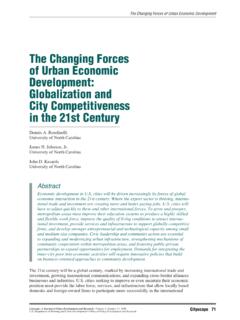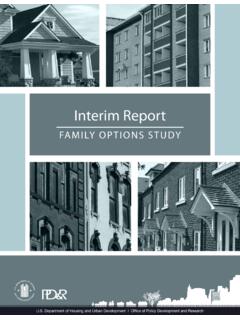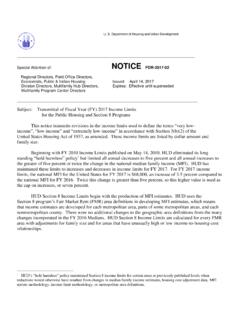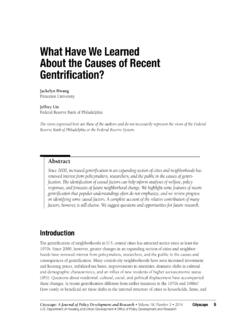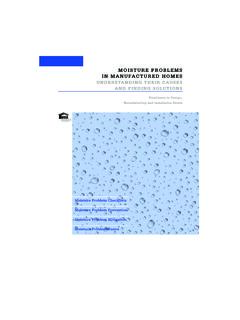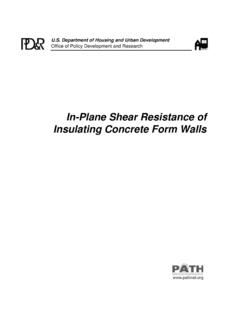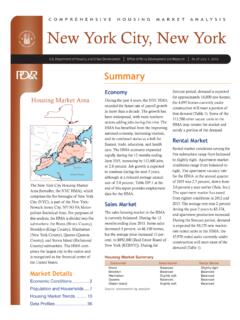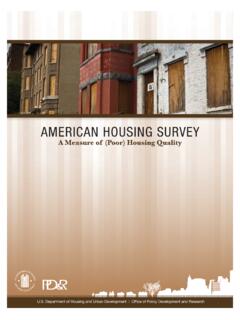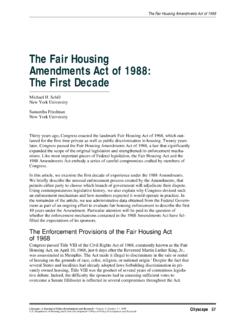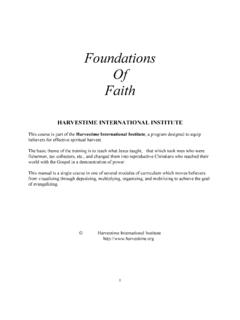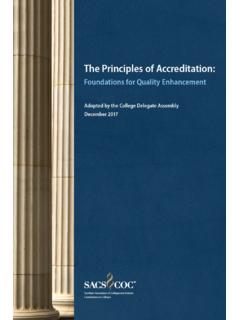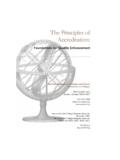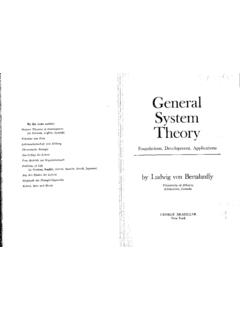Transcription of GUIDE TO FOUNDATION AND SUPPORT SYSTEMS FOR …
1 G U I D E T O F O U N D AT I O N A N D S U P P O RT. S Y S T E M S F O R M A N U FA C T U R E D H O M E S. Excellence in Design, Manufacturing and Installation Series DRAFT Not for Distribution March 27, 2002. Factors to Consider in Design Non-proprietary FOUNDATION and SupportSystems Proprietary FOUNDATION and SUPPORT SYSTEMS Department of Housing and Urban Development Office of Policy Development and Research PATH (Partnership for Advancing Technology in Housing) is a private/public effort to develop, demonstrate, and gain widespread market acceptance for the next generation of American housing. Through the use of new or innovative technologies the goal of PATH is to improve the quality, durability, environmental efficiency, and affordability of tomorrow's homes. PATH is managed and supported by the Department of Housing and Urban Development (HUD).
2 In addi . tion, all Federal Agencies that engage in housing research and technology development are PATH partners including the Departments of Energy and Commerce, as well as the Environmental Protection Agency (EPA). and the Federal Emergency Management Agency (FEMA). State and local governments and other participants from the public sector are also partners in PATH. Product manufacturers, home builders, insurance compa . nies, and lenders represent private industry in the PATH partnership. To learn more about PATH, please contact: 451 Seventh Street, SW. Washington, 20410. 202-708-4250 (phone). 202-708-5873 (fax). e-mail: Visit PD&R's Web Site to find this report and others sponsored by HUD's Office of Policy Development and Research (PD&R). Other services of HUD USER, PD&R's Research Information Service, include listservs;. special interest, bimonthly publications (best practices, significant studies from other sources).
3 Access to public use databases; hotline 1-800-245-2691 for help accessing the information you need. G U I D E T O F O U N D AT I O N A N D S U P P O RT. S Y S T E M S F O R M A N U FA C T U R E D H O M E S. Excellence in Design, Manufacturing and Installation Series Prepared for: Department of Housing and Urban Development Office of Policy Development and Research Prepared by: Manufactured Housing Research Alliance New York, NY. DRAFT Not for Distribution March 27, 2002. ACKNOWLEDGEMENTS. The Manufactured Housing Research Alliance wishes to acknowledge the assistance, advice, and guidance of a number of people without whose help this publication would not have been possible. The effort was lead by a project steering committee: Bill Farish, Fleetwood Enterprises, Project Chair Ed Bryant, Champion Enterprises Charles Fanaro, Hi-Tech Housing Bill Freeborne, Department of Housing and Urban Development James Reitzner, Asset Development Group Andrea Vrankar, Department of Housing and Urban Development Roger Walker, Ventana Development, LLC.
4 Frank Walter, Manufactured Housing Institute Other industry representatives whose advice and guidance helped shape the GUIDE : Gary Austin, Mobile Corral Homes, Inc. Bader, Mausten Home Sales David Conover, National Evaluation Service Pamela B. Danner, Danner and Associates Brian Fannon, Sun Communities Siavash Farvardin, National Evaluation Service Doug Gorman, Home Mart John Ingargiola, Federal Emergency Management Agency Therese P. McAllister, Greenhorne & O'Mara Barry McCabe, Hometown America Communities Gary McDaniel, Chateau Communities Rick Mendlen, Department of Housing and Urban Development George Porter, Manufactured Housing Resources Roger Wendt, Sunrise Home Service Companies that submitted designs or product information: The Anchor Post Company, LLC. Asset Development Group Chateau Communities Cherry Hill Homes CWS Communities Fast Track FOUNDATION SYSTEMS Fleetwood Homes Goff's Fleetwood Home Center Jensen's, Inc.
5 JM Products, Inc Oliver Technologies, Inc. Roger Huddleston Manufactured Homes Tie Down Engineering Ventana Development, LLC. Design, production, and editorial subcontractors: Hoi L. Chu, HLC Group Dorothy Foster Jennifer Goode Robert LaPointe MHRA staff responsible for coordinating and facilitating development of the GUIDE : Emanuel Levy, Executive Director Ed Salsbury, Project Coordinator Sandra Ho, Editorial Director Ian Klose, Staff Kathleen Boodoo, Staff D I S C L A I M E R O F W A R R A N T I E S A N D L I M I TAT I O N O F L I A B I L I T I E S. Neither the authors, nor reviewers, nor the Department of Housing and Urban Development, nor the Manufactured Housing Institute, nor the Manufactured Housing Research Alliance, nor any of their employees or representatives makes any warranty, guarantee, or representation, expressed or implied, with respect to the accu.
6 Racy, effectiveness, or usefulness of any information, method, or material in this document, nor assumes any lia . bility for the use of any information, methods, or materials disclosed herein, or for damages arising from such use. This publication is intended for the use of professional personnel who are competent to evaluate the significance and limitations of the reported information and who should accept responsibility for the application of the material it contains. All responsibility as to the appropriate use of information in this document is the responsibility of the reader or user. The contents of this report are the view of the contractor and do not necessarily reflect the views or policies of the Department of Housing and Urban Development or the US government. Neither the government, nor MHRA endorse products or manufacturers.
7 Trade or manufacturer's names that appear herein are used solely because they are considered essential to the objective of the report. Companies that appear in Chapter 4 paid a fee to include their material in the GUIDE . Other FOUNDATION suppliers that MHRA was aware of are listed at the end of Chapter 4. All manufacturers are welcome to participate in future versions of the GUIDE . Any claims made by a company were not independently verified by MHRA and makes no representation or warranties of any kind, either express or implied, including but not limited to warranties of title, noninfringement or implied warranties of merchantability or fitness for a particular purpose and expressly disclaims any liability with respect to the content or accuracy of this information. This is not a consumer report. There is no relative ranking of SYSTEMS .
8 MHRA does not endorse, certify or control the FOUNDATION SYSTEMS presented as case studies in Chapter Three or the company proprietary FOUNDATION SYSTEMS presented in Chapter Four. The views and opinions of the companies expressed in Chapter Four do not necessarily state or reflect those of MHRA, and shall not be used for advertising or product endorsement purposes. MHRA does not guarantee the accuracy, completeness, currency or reliability of the information submitted by the companies concerning their proprietary FOUNDATION SYSTEMS . The information obtained from this GUIDE is provided without warranties of any kind, either express or implied, including but not limited to warranties of title, noninfringement or implied warranties of merchantability or fitness for a particular purpose. The use of any information contained in these materials is voluntary, and reliance on it by the user should be under.
9 Taken after an independent review of its accuracy, completeness, currency and reliability. The SYSTEMS included in this GUIDE are representative of the SYSTEMS MHRA was aware of at the time of publication. MHRA does not imply that these are all of the SYSTEMS that exist. COPYRIGHT NOTICES. Table , Figures and are Copyright 2000, International Code Council, Inc., Falls Church, Virginia. 2000. International Residential Code and copyright 1995 One- and Two-Family Dwelling Code. Reprinted with permission of the author. All rights reserved. Figure is Copyright 1996, BOCA International, Country Club Hills, Illinois. BOCA National Building Code/1999. Commentary. Reproduced with permission. All rights reserved. PHOTO CREDITS. Courtesy of Anchor Post Company: Figures Courtesy of Asset Development Group: Figure Courtesy of Cherry Hill Homes: Figures , , Courtesy of Goff's Fleetwood Homes: Figure Courtesy of Fast Track foundations SYSTEMS : Figures Courtesy of Roger Huddleston Manufactured Homes: Figures , Courtesy of Steve Hullibarger: Figures , , , , , , , , , , Courtesy of Jensen's, Inc.
10 : Figures , , , Courtesy of JM Products: Figures Courtesy of Manufactured Housing Institute: Figures , , , , Courtesy of Oliver Technologies: Figures : Courtesy of Tie Down Engineering: Figures Courtesy of Ventana Development: Figures , , FOREWORD. For several decades, manufactured homes built to the preemptive Federal Manufactured Home Construction and Safety Standards have been the nation's foremost source of unsubsidized affordable housing. Until relatively recently, the majority of manufactured homes were economical single section designs, financed with asset-backed loans, sold most often to first-time home buyers and seniors and located in suburban and rural settings. Manufactured homes were also distinguished from their site-built counterparts in the way they were secured to the ground the majority are held in place by pier and anchor SYSTEMS .
